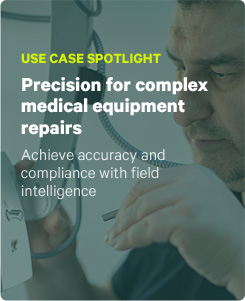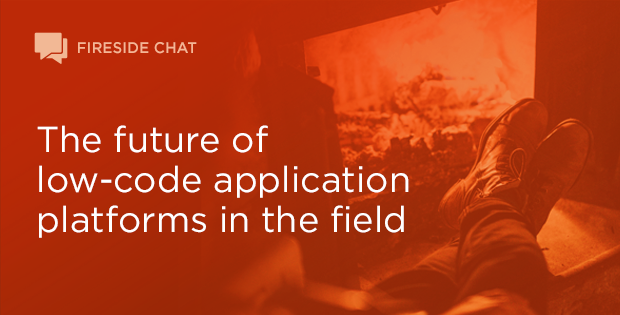During the last fireside chat, our product superstars gave the low down on LCAP and field service. This time, TrueContext’s Senior Product Manager and part-time horse whisperer Danielle Morley and Product Management VP Russ Halliday sit down around our metaphorical fireside (metaphorical marshmallows not included) to discuss the impact of low-code application platforms on the future of field service. Read below to get an insider’s look into how field service has changed and how to future-proof your organization.
As part of the product team, you’re hyper-close to those involved in field service and their needs. How have you seen these needs change over the past five years?
DANIELLE: The biggest change we’ve seen in field service is how companies are looking at the business impact of their field service organization. That perception directly affects how much they value innovation in that area.
Traditionally, field service has been seen as a cost center. Essentially, field service was a necessary function to repair customer equipment when it broke but not a revenue generator. The focus was purely on keeping costs low. Generating revenue was for a different part of the business. But more companies have started to face a lot of competitive pressure and it’s getting harder to remain competitive purely based on revenue from product sales. Attention has shifted to aftermarket services as a way to differentiate and tap into new sources of revenue.
Aftermarket services are pretty key then?
DANIELLE: Well, what we’re seeing now are field service organizations upping their game. They aren’t delivering the break-fix service of the past. They’re focusing their service offerings based on customers’ desired outcomes. Here’s an example: Let’s say you manufacture robots that are used on a production line. Your customers aren’t buying a robot anymore–they’re buying maximum uptime for their entire production line.
This is an outcome-based approach to service.
When a business can leverage service to provide better customer outcomes than its competitors can, it becomes a competitive differentiator and a revenue source. They have the happiest customers who are willing to pay more for that uptime. That means they can charge for premium service contracts and will likely have more repeat purchases from their customers. With an outcome-based model, field service starts to have a larger business impact. It becomes revenue-generating. The moment something generates revenue, people want to measure it and optimize it. That’s when innovation in your field service department starts to look like a more valuable business opportunity.
Because of that, we’re seeing IT get more interested in helping field service teams with their digital transformation. Of course, they still care about reducing costs, but innovation isn’t just “How can I make this cheaper?” it’s also “How can I transform my business?”
Okay, shameless plug, how has ProntoForms (now TrueContext) worked to meet those changing needs?
DANIELLE: Core day-to-day users of ProntoForms (now TrueContext) are not part of an IT organization so we have invested in developing tools for business users and citizen developers that make it easy to build more sophisticated field service apps. Over the last two years, we’ve released several features that build more complex business logic into forms–without using any code.
On the flip side, we doubled down on the things IT teams need out of a platform. This way, as innovation in field service gets more attention, field service organizations can easily get buy-in from IT.
ProntoForms (now TrueContext) has always prioritized security and availability, but since these are top of mind for IT, we’ve achieved SOC 2 Type 2 compliance certification by a 3rd party auditing firm. This certification gives IT teams confidence that ProntoForms (now TrueContext) has great uptime and that data privacy and security are core to our business controls and practices.
As IT gets more involved, it’s also typically expected that field service data lives in the same system that the rest of the company uses. ProntoForms (now TrueContext) has been built from the ground up to support integration with any system. With codeless connectors, citizen developers can do the work on their own with IT there to support them as needed. We’re continuing to build out our integrations by making them more configurable and also focusing on better connectivity to corporate back-office systems.
Looking forward to the future, how do you see low-code application platforms’ (LCAP) place in field service changing? Any insights you can provide for those looking to futureproof their operations?
RUSS: The pace of changing technology–and business along with it–is staggering and accelerating. One of the biggest challenges for companies over the next number of years is finding a way to remain nimble enough to capitalize on that change. It can and will be, a competitive differentiator if you can see technology and market trends as they emerge, harvest them, make use of them, and add value to your business based on them.
LCAP in particular lets you stay agile by building prototypes to evaluate whether these technologies make sense for the business problems you’re trying to solve. It also completely shortens the time it takes to get them deployed and into production. If you use traditional, whole software development methodologies, you might experience the horrors of endless trial and error. These expensive cycles cost your business time and money only to finally figure out how you should have done it in the first place.
Tie that back into the business and you have a powerful, technology-driven cycle that continuously drives improved processes, deeper insights, and better end-customer experiences–all while being incredibly agile.
What are some exciting use cases you see coming down the pipeline for AI/IoT/machine learning in field service?
RUSS: In this day and age, to stay nimble you have to change.
Tech advancements, in particular, have such a quick emergence-to-adoption cycle. You can easily get left behind if your competitors can adapt faster than you’re able to judge whether they make sense for you or not.
Look at field service three years ago: IoT (the Internet of Things) and big data were practically science projects. Now they’re mainstream and a serious consideration for field service teams.
IoT provides real-time, high-fidelity insights from sensor computer data. Machine learning gives us the tools to analyze and learn from the volumes of data being produced. These can be distilled into much better decision-making support at the front as well as better support for the back end of the business. When you put all of these things together, one fantastic asset maintenance outcome emerges: we are within striking distance of pure predictive maintenance. This means we will know, based on real-time data, when something is likely to fail.
What would predictive maintenance look like in field service?
RUSS: A technician who is doing a routine inspection will know in advance that there’s a high probability a particular component will fail within the next six to eight weeks. The technicians can have that component with them when they’re on-site to automatically maintain the uptime of the asset.
Ideally, with this model, assets never break. The whole model of run-to-failure becomes obsolete. You now have a situation where you can offer completely different warranty services and inspection programs. You can become a real revenue center, not a cost center.
Arming frontline workers with that kind of insight has the potential to unlock completely new options in terms of services offered while delivering a fantastic end-customer experience.
Conclusion
The future of field service is bright. We’ve already come a long way in aftermarket services over the past five years and as AI, IoT, and machine learning continue to integrate into field service, these services will continue to grow and mature.




